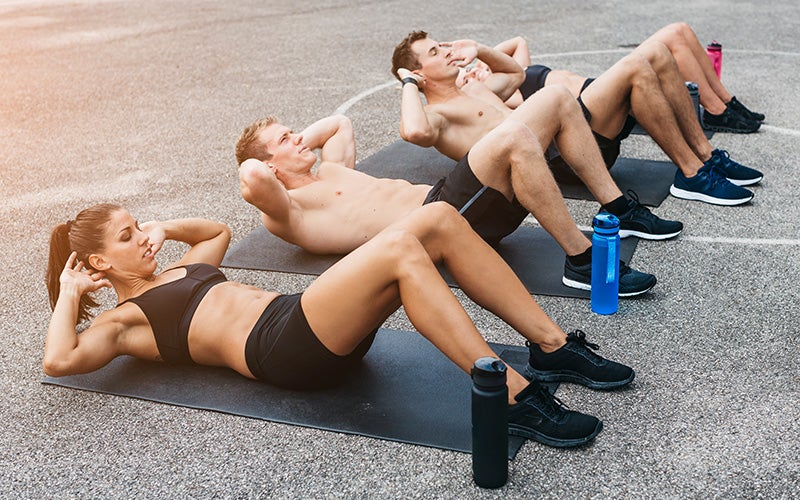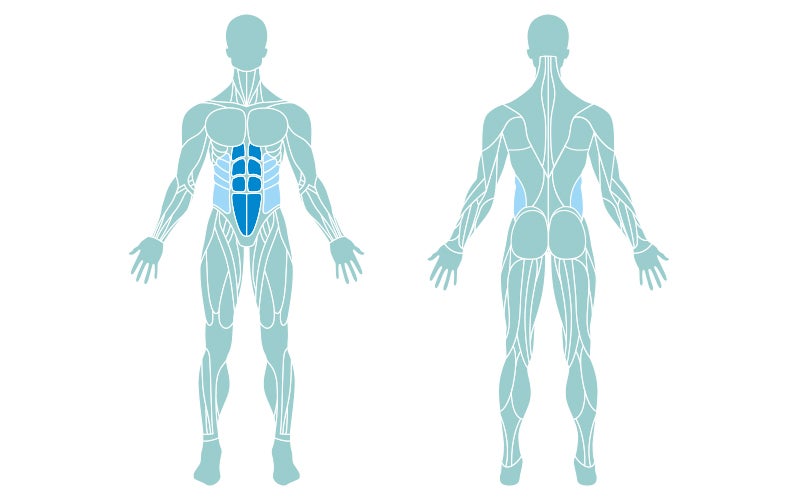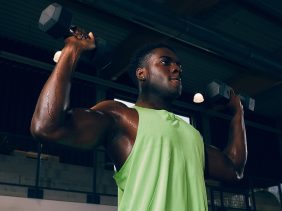Crunches: The best technique and variations for solid core muscles
 ©Westend61
©Westend61
Crunches are among the most popular exercises for the abdominal muscles. Here you can find out what this abs exercise really does, how to perform it correctly, and what kinds of variations there are.
What is a crunch?
The crunch is an exercise for the rectus abdominis (your abs) and a popular alternative to sit ups. During the exercise you crunch or press your abdominal wall together; when lying on your back, you lift your upper body slightly off the floor and pull your torso towards your legs using the strength of your abdominal muscles – without sitting up completely.
Crunches can be performed statically or dynamically. In the static version, you hold the abdominal tension for a certain time, whereas in a dynamic crunch you lift and lower for as many repetitions as you like.

Some advantages of crunches are that they are easy to perform, back-friendly, and that you don’t need a personal trainer or any equipment. Therefore they’re ideal for a pure bodyweight training or beginners home workout.
Do you feel like exercising? With our free foodspring workouts, tailored to your goals and training level, you can train effectively at home. Your choice: select from many different workouts.
What’s the difference between Crunches and Sit-ups?
Like crunches, sit ups are a popular abdominal muscle exercise that no athlete can do without. The two exercises begin similarly. For a crunch, you lift only slightly off the floor. In contrast, the goal of a sit-up is to sit up completely.
Sit-ups also train the hip flexor, while crunches specifically activate the rectus abdominis.
Sit-ups are considered more demanding because correct execution requires more torso tension than crunches. That’s why beginners are often advised to start with a crunch or one of its variations.
How effective are crunches?
Crunches are isolation exercises, meaning they are used to train a specific muscle group, namely the rectus abdominis muscles. In contrast, compound exercises such as knee bends or pull-ups activate several muscle groups at the same time.

A well structured training plan should always include a mix of compound and isolation exercises. So be sure not to focus exclusively on crunches, but also other exercises for your back, upper body and chest, arms and legs to train your body all over.
Crunches specifically activate your body’s core muscles and, if performed correctly, stimulate muscle gain. A strong abdominal musculature is absolutely worthwhile: together with the back muscles it stabilizes and supports the spine. You can improve your posture by abdominal training with crunches, counteract an arched lower back, and prevent back problems. Plus: a strong core improves balance and body tone, which is beneficial in all sports – whether weight training, running, or yoga.
An important point for anyone whose goal is a visible six pack: it’s not your abs workouts that are primarily responsible for this. Although they strengthen your muscles, they do not reduce abdominal fat themselves. Getting the right nutrition is the main factor for a defined mid-section.
So in addition to exercise, make sure you eat a protein-rich diet and support your body with essential nutrients. A good supplement for those who don’t want to spend much time in the kitchen is our Whey Protein – rich in protein and as delicious as a milkshake, and super easy to shake up in seconds.
What do crunches train?
A conventional, basic crunch focuses on training the rectus abdominis, but they also target the obliques and deep core muscles.

Primary muscle groups:
- Rectus abdominis / abdominal muscle: The abdominal muscle is what’s responsible for a visual six pack and is an important postural muscle. It pulls the chest towards the legs and keeps the trunk bent.
- Musculus pyramidalis / pyramidalis muscle: The pyramidal muscle is a triangular skeletal muscle that is anterior to the rectus abdominis. It strengthens the connection between the abdominal and pelvic floor muscles..
Supporting muscle groups:
- Musculus obliquus internus abdominis, Musculus obliquus externus abdominis / Internal & external oblique abdominal muscles: The lateral abdominal muscles are responsible for rotation in the upper body and contribute to a narrow waist and defined abs. They are also activated during a basic crunch.
Are you getting the urge to work out? With our free foodspring workouts you can train effectively and efficiently at home. Tailored to your goals and your training level, you can decide from one of our many different workouts.
Can crunches help you lose weight?
Crunches make for strong abs, but are no guarantee for a visible six pack. Nutrition and a calorie deficit are more important than exercise to lose abdominal fat. Nevertheless, you can increase your calorie expenditure with exercises like crunches. This is because the more muscle mass you have, the higher your basal metabolic rate is.
How many calories you burn during a workout depends on many factors – including age, gender, weight, and genetic predisposition, as well as speed, breaks, and number of repetitions.

Our tip: To boost your fat burning and work on your six pack at the same time, HIIT is the ideal training method. Crunches and their variations are a popular exercise during high-intensity workouts.
How many crunches should you do per day?
More means more? Not necessarily! Finding the right balance is also crucial for abs training. In order for muscles to grow, they not only need regular exertion, but also sufficient time for regeneration.
So instead of doing crunches every day, do 4 x 25 repetitions three to four times a week. On top of that, most full-body exercises such as squats, push-ups, or lunges, as well as endurance sports, also engage your abdomen. This makes it all the more important to pay attention to recovery times and support your body in regenerating. For example, try our Recovery Aminos, which thanks to quickly available carbohydrates and essential amino acids, quickly get you back in shape for your next session.
Execution: how to do a crunch properly
If you want to perform a basic crunch correctly, the following step-by-step instructions will help:
- Start by lying on your back with your legs bent at 90 degrees. Your feet should be far enough away that you can just touch your heels with your hands.
- Make sure that your lower back stays firmly glued to the floor. Press your tailbone into the mat.
- Bring your hands behind your head, fan your elbows wide, and pull your shoulder blades back and down so that your upper back is even. Alternatively, you can cross your arms in front of your chest or extend them along your sides.
- Look up towards the ceiling. Keep the head and neck in line with the spine. You should be able to fit a fist between your chin and chest.
- Now tuck the navel to build up tension in your core. Using your abs, lift your upper back including the shoulder blades off the floor – crunch or press the abdomen towards the legs. Exhale.
- Hold the tension and lower yourself in a controlled manner as you inhale, keeping your upper back and shoulder blades above the ground.
4 crunch exercises
Add variety to your abdominal training with our four crunch exercises. For more intensity or variety, you can always add dumbbells, kettlebell, resistance bands, or other equipment.
Heel Crunch/Foot Tap Crunch
Start in the basic crunch position: supine, legs at 90 degrees, heels set far enough to touch them with your fingertips. Extend your arms to the sides. Tense up your abs and lift your head and upper back slightly off the ground, just like in a classic crunch. Now rotate from right to left so that you alternately touch your ankles/feet with your fingers. The movement is similar to a windshield wiper. This crunch variant particularly activates the lateral abdominal muscles.
Crunch with twist
Come into the basic position, hands behind your head. Lift the upper back from the floor. Now bring one knee towards your belly and touch it with the opposite elbow by turning your upper body sideways. Work from the strength of your abs and obliques and be careful not to pull your head and neck. Return to the starting position and repeat on the other side. Always alternate twisting and crunching.
Bicycle Crunch
Lie on your back and put your hands on your head. This time, raise your legs, thighs, and lower legs to form a 90 degree angle with your knees above your hips. Stretch out one leg and bring it towards the ground without placing it on the floor. At the same time, twist and reach for your other knee with your elbow. Rebend your stretched leg and repeat on the other side. Start moving more fluidly, just like riding a bike.
Reverse Crunch
Start on your back, legs stretched out on the ground. Bring your hands to the head or place them under the lumbar spine as support. Tense your abs and lift your upper back. Now pull the legs towards your belly and then bring them back to the floor in a controlled way without placing them down. Make sure that your lower back stays on the floor and that you don’t arch your back. Increase the exercise’s intensity by stretching your legs completely out.
The 5 most common mistakes when doing crunches
In order for your sweat sessions on the mat to be worth the effort and for you to reap the benefits, the right technique is crucial. Here are a few common mistakes and how to avoid them:
#1 You’re relying on momentum
If you work with momentum instead of using the power of your abdominal muscles, you risk putting unnecessary strain on your back. It happens frequently that athletes start the exercise too quickly and then let themselves fall back to the floor. This way, you don’t work the abs, but the hip flexors. Be sure to do the exercise in a controlled manner, maintain abdominal tension, and only move your upper back.
#2 You’re sitting up too far
The closer you bring your upper body towards your legs, the harder your hips are working. This is intentional during a sit-up. With a crunch, though, you should only lift far enough off the floor that your lower back stays on the mat. That way, your abs are doing all the work.
#3 You’re working from the shoulders
The most important rule for a crunch: keep your abs tight! If they aren’t (yet) strong enough, you may wind up just lifting your shoulders off the ground and rounding your upper back. Press your lumbar spine into the mat and pull your navel under your ribs. Before you start, consciously pull your shoulder blades down and back.
#4 You’re pulling your head and neck
A common mistake. If you aren’t tensing your abs, you might compensate by tugging on the head and neck. But this increases the pressure on the cervical spine. Instead of bringing your hands to your temples, you can try extending your arms to your sides or crossing them in front of your chest. In any case, make sure that your head and neck stay in a straight line with your back. To check your posture: You should be able to fit a fist between your chin and sternum.
#5 You’re holding your breath
Abdominal muscle exercises quickly shorten your breath, since you’re tensing up your upper body. As soon as you catch yourself holding your breath, though, pause briefly and find your steady breathing again. Remember to exhale when you sit upright and inhale when you go back down.
Sources for this article
We at foodspring use only high-quality sources, including peer-reviewed studies, to support the facts within our articles. Read our editorial policy to learn more about how we fact-check and keep our content accurate, reliable, and trustworthy.

































